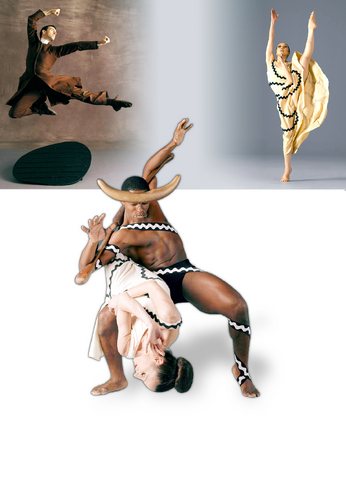The Martha Graham Dance Company is the oldest dance company in the US, the repository of some of the most iconic and groundbreaking choreography of the 20th century.
But it is also a company that has struggled hard to survive in the 15 years since its founder died at age 97, including a three-year legal battle over ownership of the dances themselves that was as epic as any of the Greek myths that Martha Graham frequently used for inspiration in her work.
Taiwan-born principal dancer Sheu Fang-yi (

PHOTO COURTESY JOHN DEANE, MARTHA GRAHAM DANCE COMPANY
Now she is leading the Graham troupe's return to Taipei to show local audiences the work that has made her world renowned. Under-standably, much of the media and audience focus of this weekend's performances has been on her.
Frances Mason, chairman of the board of trustees of the Martha Graham Center of Contemporary Dance, served as spokesman at a press conference at the National Theater yesterday afternoon, saying how pleased the company was to be in Sheu's home country.
He said Martha Graham herself loved to be in Taipei and to watch the modern dance training at the National Institute of the Arts (now Taipei National University of Arts), where one of her former principal dancers, Ross Parkes, has directed modern dance training for many years and where others from the company continue to demonstrate Graham's works.
"Sheu symbolizes the beauty and power of the Martha Graham repertoire found in the world-class Cloud Gate Dance Theater and the brilliant work of its director Lin Hwai-min (
"I think its safe to say that it [modern dance] is now in your bloodstream," he said.
Mason said the appeal of Graham's work transcends national and cultural boundaries.
"I think people everywhere, no matter what the nationality, when they see the company they catch on to Martha Graham ... especially young women seeing Steps in the Street [an excerpt from Chronicle] knows `that could be me,'" Mason said.
"Martha Graham is an individual speaking to other individuals through dance," he said. "She brings the inner self out."
Graham was a colleague of, an inspiration for and a trainer of some of the greatest names in 20th century modern dance, music and art. In the years after she founded her company in 1926, the roster of her dancers who went on to found their own troupes or to choreograph is amazing: Merce Cunningham, Erick Hawkins, Elisa Monte, Paul Taylor, Glen Tetley and Twyla Tharp.
And yet Graham's legacy is centered as much on her own performances as a dancer in the 1930s and 1940s, as it is on her choreography, which is why such famous ballet dancers as Margot Fonteyn, Rudolf Nureyev and Mikhail Baryshnikov were so eager to dance for her.
The company is offering two entirely different programs for its two-day visit, but both give audiences a chance to see why Graham was such a groundbreaker -- and a polarizer -- and why the Graham Technique became such a major force in the world of dance.
Grahams' falls, spastic pelvic contractions, trembling bodies and floor work became her trademarks. Now they are considered basic vocabulary in the language of dance and theater.
Tomorrow's program features Errand into the Maze, Appalachian Spring and Chronicle. Sunday's performances will begin with three solos, Deep Song, Satyric Festival Song and Lamentation, followed by Cave of the Heart and Acts of Light. With one exception, these pieces all date from the 1930s and 1940s.
While the company is the repository of 181 of Graham's works, its repertoire in the past few years has been centered around her early works and rightly so, for these showcase her choreography at the height of her creativity.
Errand into the Maze is one of the three Graham "classics" that Taipei audience will have a chance to see (the others are Appalachian Spring and Lamentation). This 1947 work explores the legend of Ariadne and the Minotaur and is a Jungian-based meditation on fear and coming to grips with fear. For decades it has been seen as a story of a woman coming to grips with a fear of sex.
Appalachian Spring, set to Aaron Copeland's wonderful score, is one of Graham's best-known works. This 1944 piece about the marriage of a pioneer couple is Graham's interpretation of the folklore and myths of the American frontier.
With its jumping preacher man and love-struck bride and groom, its lightness and optimism, Spring is Graham's most approachable piece, even for those people who can only be dragged kicking and screaming to a performance of modern dance. Proof of this is that for many years Spring was also a staple in the repertoire of the American Ballet Theater.
Rounding out the first day of performances is Chronicle, a suite from 1936. This is one of the pieces that the company has recreated since Graham's death, based on photographs, the memories of older dancers and film clips.
Sunday's matinee and evening performances begin with a trio of solos: the 1937 Deep Song, Satyric Festival Song from 1932 and Lamentation from 1930, the latter two being pieces strongly identified with Graham the dancer.
Deep Song was conceived as a protest against the Spanish Civil War. It stands as a reminder of how Graham the artist reacted to and was inspired by the contemporary world. It can also be seen as the forerunner of the company's outreach programs, for in recent decades the company has created workshops to help children in Scotland, Kosovo and New York City deal, through dance, with crises such as the Balkan wars, the Lockerbie bombing and the Sept. 11 attacks.
The humorous Satryric, which was originally one element of a five-part suite, was recreated in 1994, basically from a series of famous photographs of Graham dancing taken by Barbara Morgan. The last time it had been performed by the company was in the mid-1940s.
Lamentation was one of Graham's first "tube" pieces, with the dancer encased in a sack made out of jersey, that allowed Graham to explore shapes as well as movement, and by obscuring the dancer, allows her to become an everywoman.
Cave of the Heart, from 1946, is, as the title suggestions, another of Graham's retelling of Greek myths. It is also one of her most graphic works, with a horror-inspiring solo in which Medea eats her own entrails.
Acts of Light, from 1981, is the exception to the "old piece" rule this weekend. The title of the piece comes from a letter written by 19th-century American poet Emily Dickinson but the dance itself centers on the eternal Graham themes, of love, sex and death. Set to three short works by Danish composer Carl Nielsen, it begins with a lament, an echo really of the Lamentation, with a sack-draped woman and her attendant males. The second part is a duet for two lovers and the third is almost an homage to the forces of nature.
Sheu will be dancing in Errand in the Maze and Chronicle on Saturday and Cave of the Heart and Acts of Life on Sunday.
Graham was frequently quoted as saying that her mission in life was to "chart the graph of the heart." She did this by evoking strong, almost visceral emotions, both in her dancers and in her audiences. Her women-centered work continues to resonate as strongly today as it did when first performed.
For your information :
What: Martha Graham Dance Company
Where: National Theater of the CKS Memorial Hall, 21-1, Zhongshan S Rd, Zhongzheng District, Taipei City (
When: Tomorrow and Sunday, 2:30pm and 7:30pm
Tickets: The only tickets left for all four performances are NT$2,000, NT$2,500, NT$3,000; available online through www.artsticket.com.tw or at the theater box office

May 11 to May 18 The original Taichung Railway Station was long thought to have been completely razed. Opening on May 15, 1905, the one-story wooden structure soon outgrew its purpose and was replaced in 1917 by a grandiose, Western-style station. During construction on the third-generation station in 2017, workers discovered the service pit for the original station’s locomotive depot. A year later, a small wooden building on site was determined by historians to be the first stationmaster’s office, built around 1908. With these findings, the Taichung Railway Station Cultural Park now boasts that it has

Wooden houses wedged between concrete, crumbling brick facades with roofs gaping to the sky, and tiled art deco buildings down narrow alleyways: Taichung Central District’s (中區) aging architecture reveals both the allure and reality of the old downtown. From Indigenous settlement to capital under Qing Dynasty rule through to Japanese colonization, Taichung’s Central District holds a long and layered history. The bygone beauty of its streets once earned it the nickname “Little Kyoto.” Since the late eighties, however, the shifting of economic and government centers westward signaled a gradual decline in the area’s evolving fortunes. With the regeneration of the once

The latest Formosa poll released at the end of last month shows confidence in President William Lai (賴清德) plunged 8.1 percent, while satisfaction with the Lai administration fared worse with a drop of 8.5 percent. Those lacking confidence in Lai jumped by 6 percent and dissatisfaction in his administration spiked up 6.7 percent. Confidence in Lai is still strong at 48.6 percent, compared to 43 percent lacking confidence — but this is his worst result overall since he took office. For the first time, dissatisfaction with his administration surpassed satisfaction, 47.3 to 47.1 percent. Though statistically a tie, for most

In February of this year the Taipei Times reported on the visit of Lienchiang County Commissioner Wang Chung-ming (王忠銘) of the Chinese Nationalist Party (KMT) and a delegation to a lantern festival in Fuzhou’s Mawei District in Fujian Province. “Today, Mawei and Matsu jointly marked the lantern festival,” Wang was quoted as saying, adding that both sides “being of one people,” is a cause for joy. Wang was passing around a common claim of officials of the People’s Republic of China (PRC) and the PRC’s allies and supporters in Taiwan — KMT and the Taiwan People’s Party — and elsewhere: Taiwan and